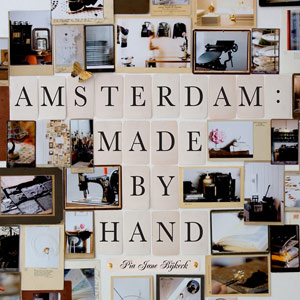Studio Visit: Textile Designer Mae Engelgeer
Amsterdam’s stylish savant of subtly colorful fabrics and her meticulous take on weaving


Amsterdam textile designer Mae Engelgeer creates such visually striking elements of home decor that she can even command attention when her product is situated on the ground among a flurry of journalists, critics and peers at the annual hubbub known as Milan’s Salone del Mobile. With its fluffy, shag-like yarns and prominent pops of richly saturated pastels, Engelgeer’s “Yeah Rug” called out from the floor of a gallery space in Ventura Lambrate with a soothing yet youthful tone that begged us to learn more about its meticulous creator. We recently had the chance to stop by her sun-drenched studio, where she elaborated on her foundation in fashion, the allure in a stylishly timeless aesthetic and where she sees her work in the future (she cites Maharam and Kvadrat as ideal collaborators). Learn more about her vision below.
How did you get started in textiles?
I graduated from the fashion academy first—here in Amsterdam—where I specialized in textile design. I graduated with a lot of handmade fabrics, silkscreens and knits, and the fabrics were more important to me than say the silhouette. Then I worked for a Dutch fashion brand to get in touch with the fashion world and we did a lot. I could do everything actually from start to finish and we traveled a lot so it was good, but I thought, “OK I want to do something for myself or with textiles.”
I found this Masters post-graduate course at the Sandberg Instituut, it’s one of the most famous at the Rietveld Academie here in Amsterdam. It was quite international, they only let six people in a year for applied arts, so for me it was good to have this material and then be in the field of autonomous design and sort of the gray field in between. I had two years of a working space and we did some exhibitions and we traveled, it was just time to find out what I wanted to do. We had lectures and talked about our work, so that was a good time to study again. When I graduated I had my first collection that I developed at the Textile Lab where I still develop the fabrics. It’s in Tilburg, in the Netherlands. It’s a textile museum and they have this lab where they have big weaving, knitting, laser-cutting and embroidery machines. You can book a day, half day or a few days, and then you work together with a project developer and they will change your pattern around in their different programs because it’s all computerized.
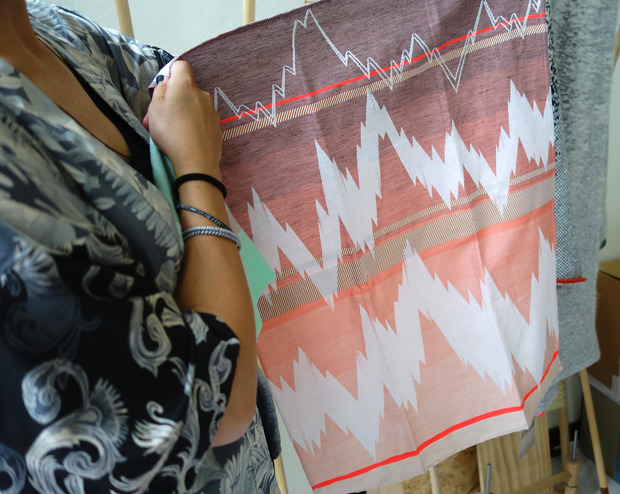
What’s your process like?
I requested the yarns that I usually work with, which is a lot of mohair and merino wool—it’s nice to have them at the studio. Then I will collect it and we place it on the machine and then we just start to run the program. And then we’ll stop it and maybe change some yarns or change the pattern, so it’s really a collaboration between the developer there who knows the machine—and who probably knows more about the bindings than me—and me, but I’ve been there for six years or something so now I understand the machine quite well. But it’s really nice to just react and respond to what you see, but before I get there we collect all kinds of things [for inspiration]. I mix some of my old samples with something I find, which might be a color or something I like about it, and maybe I’ll try to find a sock or something that just shows me what I have in mind. Even a sponge—I just like the material and the color. I try to mix and bring them together in some way. It’s just a starting point for what I have in my mind, and it’s easy for the interns to know where I’m at and to work together in the same direction.
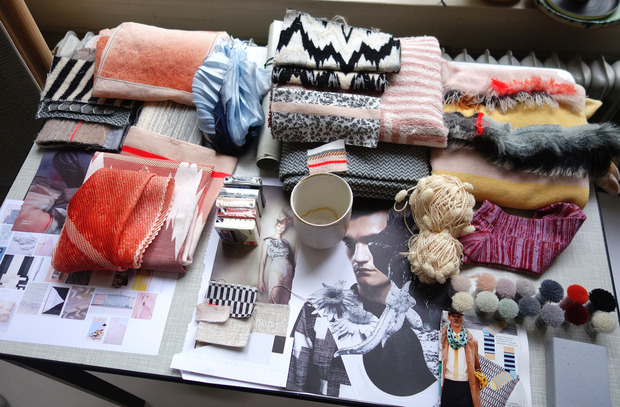
There’s a spot for me, but then you have to go for it, like with everything.
How did you go about setting up your studio?
After graduation, I did the first collection at the Textile Lab, which was the Bow Collection. The name’s the muse, it was sort of an ode to the bow as a decorative item. A guy from Amsterdam from the design store Frozen Fountain told me, “I love this, I want to have them in my store, make something out of it. I think it’s good and I can sell it.’ So that just gave me the push I needed, or pushed me into the right direction, and I thought, “Yeah, it’s fun, I’ll make a blanket out of it because then it’s still a fabric and it has a function in a way.” Then I also made cushions—I don’t really like cushions myself [laughs]—but we sold them and got a lot of responses and some new stores, and so that’s when I started a second collection, the FEST collection. Then I think just for almost two years now I’m full time, and people are liking it—I like what I’m doing. There’s a spot for me, but then you have to go for it, like with everything.
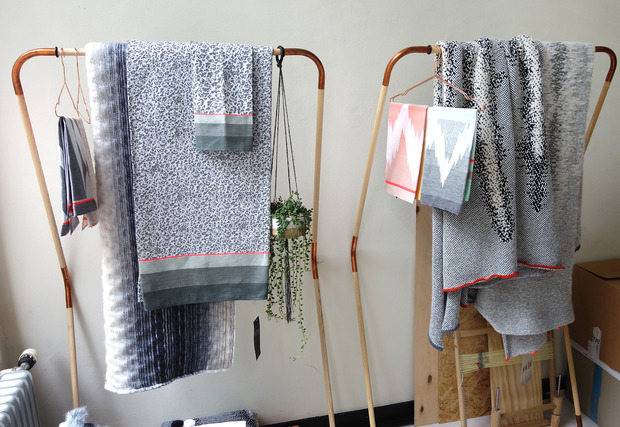
Was that when you showed in Milan?
Then I went to Milan, 2013 was the first time. I thought about it years before, but I thought, “When I go there, I must be ready for it” and if I got all kinds of responses or requests I needed to be able to follow up. I think 2013 was the best time to go there; I found out people already knew my product or my textiles and that was great to hear. This year we went again with the same group, [called] 010-020 because 010 is the code from Rotterdam and 020 is the code from Amsterdam. We wanted to give the group a name but something more visual; everybody can remember and it’s nice with the dots. We’re all friends and designers, we all do something different but with sort of the same aesthetic.
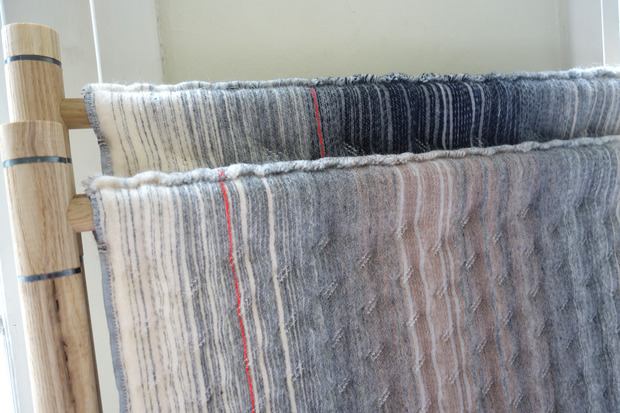
This year was even better because I made a lot of nice contacts for collaborations. I’ll start working with other brands now, and develop special ranges for them. For me, just to design is what I like. On the side I will do my own collections. I’m a textile designer; I want to do this and spread my signature. I’m working on furniture fabrics with a factory in Scotland. I got a lot of requests from architects or interior designers asking to use my fabrics on sofas or for this hotel, but you need to make them on a different machine because they need to be more durable. I think this is a nice direction to go in, so we’re making a lot of samples right now.

And you produce everything at the Textile Lab?
Yes, but for the blankets they are finished here. I don’t do it myself anymore—I used to stitch every blanket to finish it, because I wanted it to be done really nice. And the rug is made in Nepal. But for me, it’s a really nice way to do the development, standing next to the machine. And it’s really a Dutch design and Dutch-produced product. At the Textile Lab you can do really small quantities (well, I’m not really doing small quantities anymore), but if I wanted I could order just one centimeter for my own fabric. They do high-quality production, and I can order whenever I want. I always want to show a whole world, or range. So for me it’s a great way to start but then the prices are high, which fits the quality but—I think the stores don’t mind because they like to have something more exclusive or special and I think they can see the love that went into it and the handiwork in the way of the finishing—so I think I want to stay there in the lab.
I don’t want to focus on becoming a bigger brand and have to compete in prices with other labels. I think it should be like, I’m a textile designer and I do different collaborations but I also have my own collection. If you like it, then you understand why prices are the way they are, and that you’re going for a more exclusive product.
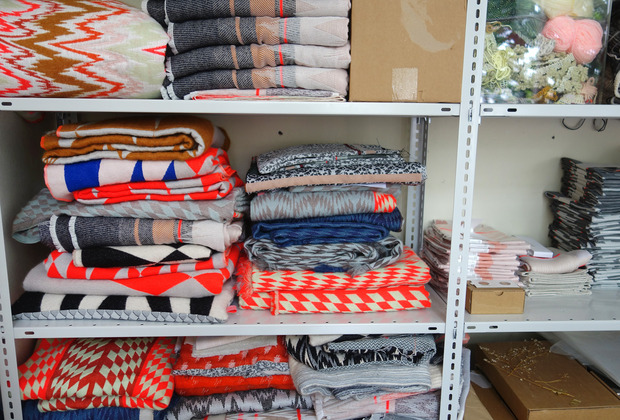
Would you say your patterns are particularly Dutch?
No, I don’t think they’re really Dutch. But I think the openness—the Dutch are quite open, not loud but not afraid to show things in a way, and that’s also how my personality is—I think you can see that in my collection. So it’s difficult to say, but the orange is not coming from my love for The Netherlands [laughs].
Is it also about creating unique textures?
It’s a mix, of that and colors. For the new placemats I thought, “I want to do placemats and I want to use this lilac color,” so that’s my starting point, in colors. But I also want to think about pattern, and I wanted to do something with this ikat kind of style, so then that’s second, and the technique is third and the type of yarn. Then I start to use the machine in a way that—you see this white glow over all the colors—that’s what we did with the chain yarn, I placed it over all the colors to make a soft layer.
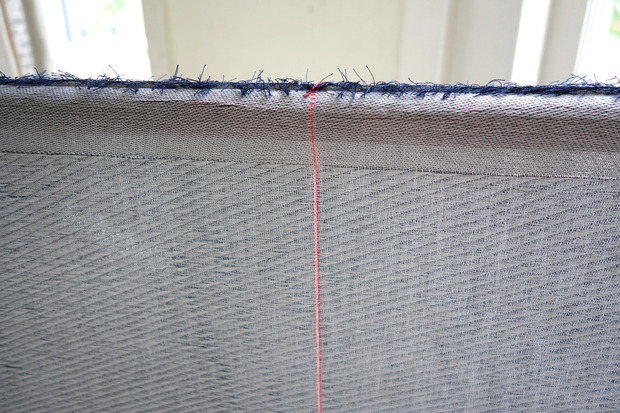
Do you spend a lot of time researching patterns?
No, I just use Pinterest or something to point out what I’m thinking about, but I work from feelings, so things have to start from there. Of course what I’ve seen [influences me]—I like to go to museums or things like that—but inspiration can come from everything. Like an ugly store with the kitchen sponges to a nice designer clothing piece. I like Bauhaus style, for example, but I’m not the type of person who will search the internet for images of that. It’s more of the feeling of the style I like.
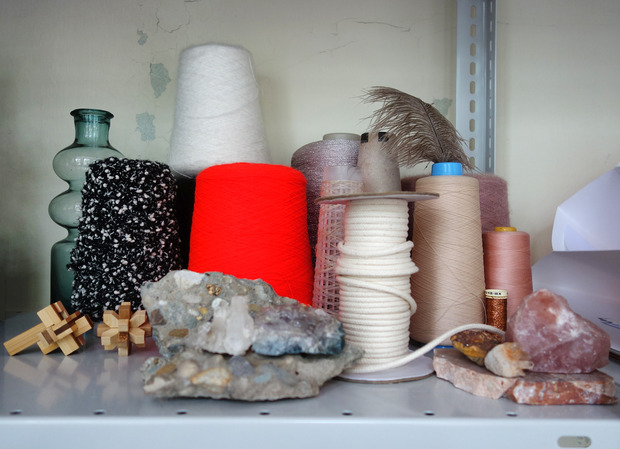
If something is good and it still fits and people like it, why would you stop it and throw away all of the time and the love you have for it?
Do you see yourself returning to fashion?
No, but I would like to do a collaboration. If I could make a whole series of textiles, of course, because I still like fashion. But I like the design world more. It’s more me. When I started I thought, “Oh this is my collection for this year”—really coming from fashion. I figured with the next collection I would stop making the first, but people still want to order from that one. We’re so used to something new. I think it fits the world better at this moment, if something is good and it still fits and people like it, why would you stop it and throw away all of the time and the love you have for it?
Mae Engelgeer’s textiles sell online and in select shops around the world.
Photos by Karen Day

